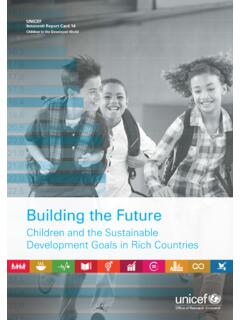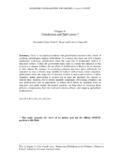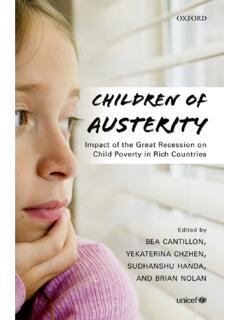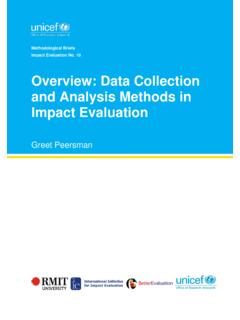Transcription of DOMESTIC VIOLENCE - UNICEF-IRC
1 DOMESTICVIOLENCEAGAINST WOMEN AND GIRLS OVERVIEW SCOPE OF THE PROBLEM MAGNITUDE OF THE PROBLEM CAUSES OF DOMESTIC VIOLENCE CONSEQUENCES CALCULATING THE SOCIO-ECONOMICCOSTS OF VIOLENCE STRATEGIES AND INTERVENTIONS:AN INTEGRATED APPROACH COMBATING DOMESTIC VIOLENCE :OBLIGATIONS OF THE STATEINNOCENTI - June 2000 DOMESTIC VIOLENCE AGAINST WOMEN AND GIRLSCONTENTSEDITORIAL1 OVERVIEW2 SCOPE OF THE PROBLEM3 MAGNITUDE OF THE PROBLEM4 Physical abuse4 Sexual abuse and rape in intimate relationships4 Psychological and emotional abuse4 Femicide 6 Sexual abuse of children and adolescents6 Forced prostitution6 Sex-selective abortions, femaleinfanticide and differential access to food and medical care 6 Traditional and cultural practicesaffecting the health and lives of women6 CAUSES OF DOMESTIC VIOLENCE7 CONSEQUENCES8 Denial of fundamental rights8 Human development goals undermined9 Health consequences9 Impact on children9 CALCULATING THE SOCIO-ECONOMICCOSTS OF VIOLENCE12 STRATEGIES AND INTERVENTIONS.
2 AN INTEGRATED APPROACH13 The family14 Local community15 Civil society 15 The state machinery17 International organizations19 LINKS20 REFERENCES25 Also includesCOMBATING DOMESTIC VIOLENCE :OBLIGATIONS OF THE STATEby Radhika Coomaraswamy10 EDITORIALW omen and children are often in great danger in the place where they should be safest:within their families. For many, home is where they face a regime of terror and violenceat the hands of somebody close to them somebody they should be able to trust. Thosevictimized suffer physically and psychologically. They are unable to make their owndecisions, voice their own opinions or protect themselves and their children for fear offurther repercussions. Their human rights are denied and their lives are stolen from themby the ever-present threat of VIOLENCE . This innocenti digest looks specifically at DOMESTIC VIOLENCE .
3 The term DOMESTIC includes VIOLENCE by an intimate partner and by other family members, wherever thisviolence takes place and in whatever form. The digest builds on the research carried outby the unicef innocenti Research Centre for an earlier digest on Children and recent years, there has been a greater understanding of the problem of domesticviolence, its causes and consequences, and an international consensus has developed onthe need to deal with the issue. The Convention on the Elimination of All Forms ofDiscrimination against Women adopted by the United Nations General Assembly some20 years ago, the decade-old Convention on the Rights of the Child, and the Platformfor Action adopted at the Fourth International Conference on Women in Beijing in 1995,all reflect this consensus. But progress has been slow because attitudes are deeplyentrenched and, to some extent, because effective strategies to address DOMESTIC vio-lence are still being defined.
4 As a result, women worldwide continue to suffer, with esti-mates varying from 20 to 50 per cent from country to country. This appalling toll will not be eased until families, governments, institutions and civilsociety organizations address the issue directly. Women and children have a right toState protection even within the confines of the family home. VIOLENCE against womenis perpetrated when legislation, law enforcement and judicial systems condone or do notrecognize DOMESTIC VIOLENCE as a crime. One of the major challenges is to end impunityfor perpetrators. So far, only 44 countries (approximately) have adopted specific legisla-tion to address DOMESTIC this digest demonstrates, DOMESTIC VIOLENCE is a health, legal, economic, educa-tional, developmental and, above all, a human rights issue. Much has been done to cre-ate awareness and demonstrate that change is not only necessary, it is also possible.
5 Nowthat strategies for dealing with it are becoming clearer, there is no excuse for inaction. Mehr KhanDirector, unicef innocenti Research CentreInnocenti innocenti digest 6 DOMESTIC Violence2 Main issuesViolence against women and girls contin-ues to be a global epidemic that kills, tor-tures, and maims physically, psycholog-ically, sexually and economically. It is oneof the most pervasive of human rights vio-lations, denying women and girls equality,security, dignity, self-worth, and theirright to enjoy fundamental freedoms. VIOLENCE against women is present inevery country, cutting across boundariesof culture, class, education, income, eth-nicity and age. Even though most soci-eties proscribe VIOLENCE against women,the reality is that violations againstwomen s human rights are often sanc-tioned under the garb of cultural practicesand norms, or through misinterpretationof religious tenets.
6 Moreover, when theviolation takes place within the home, asis very often the case, the abuse is effec-tively condoned by the tacit silence andthe passivity displayed by the state andthe law-enforcing machinery. The global dimensions of this violenceare alarming, as highlighted by studies onits incidence and prevalence. No societycan claim to be free of such VIOLENCE , theonly variation is in the patterns and trendsthat exist in countries and groups of women are more vul-nerable, including minority groups,indigenous and migrant women, refugeewomen and those in situations of armedconflict, women in institutions and deten-tion, women with disabilities, femalechildren, and elderly digest focuses specifically ondomestic VIOLENCE the most prevalentyet relatively hidden and ignored form ofviolence against women and girls.
7 Whilereliable statistics are hard to come by,studies estimate that, from country tocountry, between 20 and 50 per cent ofwomen have experienced physical vio-lence at the hands of an intimate partneror family the purpose of this digest , theterm DOMESTIC VIOLENCE includes vio-lence against women and girls by an inti-mate partner, including a cohabiting part-ner, and by other family members,whether this VIOLENCE occurs within orbeyond the confines of the home. Whilerecognizing that other forms of violenceare equally worthy of attention, thisDigest does not cover the VIOLENCE inflict-ed on women by strangers outside thehome in public places such as streets,workplaces or in custody, or in situationsof civil conflict or war. It does not look atthe issue of VIOLENCE against domesticworkers, as this is perpetrated by individ-uals who are not related.
8 In other words,the term DOMESTIC here refers to thetypes of relationships involved rather thanthe place where the violent act digest attempts to set out the mag-nitude and universality of DOMESTIC vio-lence against women and girls, and itsimpact on the rights of women and chil-dren. It emphasizes the need for coordinat-ed and integrated policy responses;enhancing partnerships between stakehold-ers; setting up mechanisms for monitoringand evaluating programmes and policies;implementing existing legislation; andensuring greater transparency and account-ability from governments in order to elimi-nate VIOLENCE against women and s groups have long pushed forOVERVIEW Definitions and Key ConceptsThere is no universally accepted definition of VIOLENCE against women. Some human rightsactivists prefer a broad-based definition that includes "structural VIOLENCE " such as poverty,and unequal access to health and education.
9 Others have argued for a more limiteddefinition in order not to lose the actual descriptive power of the any case, theneed to develop specific operational definitions has been acknowledged so that researchand monitoring can become more specific and have greater cross-cultural United Nations Declaration on the Elimination of VIOLENCE against Women (1993)defines VIOLENCE against women as "any act of gender-based VIOLENCE that results in, or islikely to result in, physical, sexual or psychological harm or suffering to women, includingthreats of such acts, coercion or arbitrary deprivation of liberty, whether occurring in publicor in private life."3 This definition refers to the gender-based roots of VIOLENCE , recognizing that "violenceagainst women is one of the crucial social mechanisms by which women are forced into asubordinate position compared with men." It broadens the definition of VIOLENCE byincluding both the physical and psychological harm done towards women, and it includesacts in both private and public life.
10 The Declaration defines VIOLENCE against women asencompassing, but not limited to, three areas: VIOLENCE occurring in the family, within thegeneral community, and VIOLENCE perpetrated or condoned by the State. DOMESTIC VIOLENCE , as defined for this digest , includes VIOLENCE perpetrated by intimatepartners and other family members, and manifested through:Physical abuse such as slapping, beating, arm twisting, stabbing, strangling, burning,choking, kicking, threats with an object or weapon, and murder. It also includes traditionalpractices harmful to women such as female genital mutilation and wife inheritance (thepractice of passing a widow, and her property, to her dead husband s brother). Sexual abusesuch as coerced sex through threats, intimidation or physical force, forcingunwanted sexual acts or forcing sex with abusewhich includes behaviour that is intended to intimidate andpersecute, and takes the form of threats of abandonment or abuse, confinement to thehome, surveillance, threats to take away custody of the children, destruction of objects,isolation, verbal aggression and constant abuseincludes acts such as the denial of funds, refusal to contributefinancially, denial of food and basic needs, and controlling access to health care,employment, etc.









